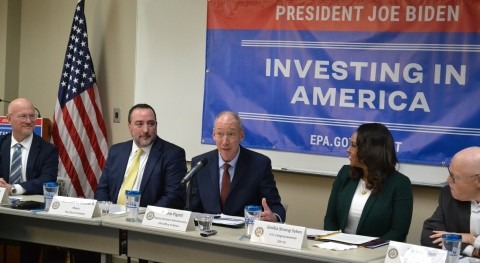On May 16, the Environmental Protection Agency posted new data confirming 89.3 million people in communities throughout the U.S. have drinking water that has tested positive for the toxic “forever chemicals” known as PFAS.
But the actual scale of the PFAS contamination crisis is likely much greater, as the EPA’s results are based just on the latest testing from about one-third of water systems that serve 90 percent of the population. All public water systems serving over 3,000 people are required by the agency to test for 29 individual PFAS between now and 2026, so more results are coming.
“We call on water utilities to inform their customers immediately if PFAS have been detected, and to begin water treatment as quickly as possible to protect their customers from these toxic forever chemicals,” said John Reeder, vice president of federal affairs at the Environmental Working Group.
The EPA’s new data underscore the importance of the Biden administration’s unprecedented efforts to tackle PFAS contamination in drinking water, clean up contaminated sites and reduce unnecessary uses of forever chemicals.
Notably, the agency in April finalized landmark drinking water standards that establish health-protective legal limits for six PFAS in tap water, including a 4 parts per trillion, or ppt, limit on PFOA and PFOS – two of the most notorious PFAS. These new enforceable standards are expected to save thousands of lives, prevent tens of thousands of serious illnesses and improve drinking water quality for millions of people.
The EPA’s new data underscore the importance of the Biden administration’s unprecedented efforts to tackle PFAS contamination in drinking water, clean up contaminated sites and reduce unnecessary uses of forever chemicals
“The EPA data reaffirm the Biden administration’s decision to issue bold new drinking water standards for PFAS,” said Reeder.
The newly posted data reflect the results of water sampling for PFAS conducted from 2023 to 2024 at 4,750 water systems as part of the agency’s Fifth Unregulated Contaminant Monitoring Rule, or UCMR 5.
The data show PFAS were present in 33 per cent of systems tested. But the latest test results released by the EPA tell only part of the story – PFAS contamination is likely much more widespread.
A 2020 study published by EWG scientists estimated more than 200 million Americans are served by water systems with PFOA or PFOS in their drinking water at a concentration of 1 ppt or higher. The EPA only reports detections at 4 ppt or higher for these chemicals.
EWG’s interactive PFAS contamination map, which is updated frequently, shows public and private water systems known to be contaminated with toxic PFAS at thousands of locations. As of May 21, 2024, the map shows PFAS are known to contaminate 6,189 locations in all 50 states, the District of Columbia and four territories.
Risks of PFAS exposure
“These chemicals are toxic at extremely low levels,” said David Andrews, Ph.D., EWG deputy director of investigations and a senior scientist. “Every week new research reveals the endless extent of contamination and detrimental impacts that PFAS exposure causes through the body.
“These new PFAS detections highlight a threat to the well-being of individuals and communities drinking this contaminated water,” he said.
PFAS are known as forever chemicals because once released into the environment they do not break down and they can build up in the body. The Centers for Disease Control and Prevention has detected PFAS in the blood of 99 percent of Americans, including newborn babies.
Very low doses of PFAS have been linked to suppression of the immune system. Studies show exposure to very low levels of PFAS can also increase the risk of cancer, harm fetal development and reduce vaccine effectiveness.
If you know or suspect PFAS are in your tap water, the best way to protect yourself is with a filtration system at home. EWG researchers tested the performance of 10 popular water filters and measured how well each reduced PFAS detected in home tap water.



















